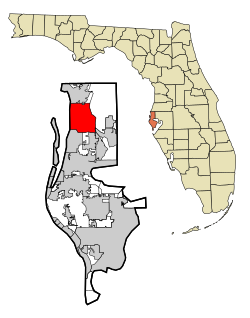2010 and 2020 census
Palm Harbor racial composition
(Hispanics excluded from racial categories)
(NH = Non-Hispanic)
| Race | Pop 2010 [22] | Pop 2020 [23] | % 2010 | % 2020 |
|---|
| White (NH) | 51,091 | 51,669 | 88.95% | 84.20% |
| Black or African American (NH) | 1,044 | 1,013 | 1.82% | 1.65% |
| Native American or Alaska Native (NH) | 103 | 85 | 0.18% | 0.14% |
| Asian (NH) | 906 | 1,257 | 1.58% | 2.05% |
| Pacific Islander or Native Hawaiian (NH) | 20 | 24 | 0.03% | 0.04% |
| Some other race (NH) | 84 | 210 | 0.15% | 0.34% |
| Two or more races/Multiracial (NH) | 784 | 2,351 | 1.36% | 3.83% |
| Hispanic or Latino (any race) | 3,407 | 4,757 | 5.93% | 7.75% |
| Total | 57,439 | 61,366 | 100.00% | 100.00% |
As of the 2020 United States census, there were 61,366 people, 26,773 households, and 16,344 families residing in the CDP. [24]
As of the 2010 United States census, there were 57,439 people, 25,779 households, and 15,909 families residing in the CDP. [25]
2000 census
As of the census [2] of 2000, there were 59,248 people, 25,461 households, and 16,906 families residing in the CDP. The population density was 1,276.6/km2 (3,306/sq mi). There were 28,044 housing units at an average density of 604.2/km2 (1,565/sq mi). The racial makeup of the CDP was 95.83% White, 0.97% African American, 0.19% Native American, 1.28% Asian, 0.02% Pacific Islander, 0.60% from other races, and 1.10% from two or more races. Hispanic or Latino of any race were 3.45% of the population.
In 2000, there were 25,461 households, out of which 27.0% had children under the age of 18 living with them, 55.3% were married couples living together, 8.5% had a female householder with no husband present, and 33.6% were non-families. 28.1% of all households were made up of individuals, and 14.2% had someone living alone who was 65 years of age or older. The average household size was 2.28 and the average family size was 2.79.
In 2000, in the CDP, the population was spread out, with 20.8% under the age of 18, 5.1% from 18 to 24, 27.1% from 25 to 44, 23.7% from 45 to 64, and 23.4% who were 65 years of age or older. The median age was 43 years. For every 100 females, there were 88.7 males. For every 100 females age 18 and over, there were 85.5 males.
In 2000, the median income for a household in the CDP was $45,404, and the median income for a family was $52,925. Males had a median income of $41,003 versus $29,287 for females. The per capita income for the CDP was $26,470. About 4.3% of families and 5.5% of the population were considered below the poverty line, including 5.2% of those under age 18 and 6.5% of those age 65 or over.


